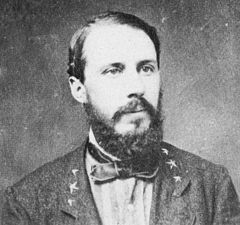Edward Porter Alexander was born In Washington, Georgia, on 26 May 1835, to a wealthy plantation family. Privately tutored, he entered the US Military Academy and was graduated third in the class of 1857. His intelligence being obvious to his superiors, he was assigned to duty immediately after graduation as an instructor at West Point, while being commissioned into the Corps of Engineers. Interrupting his teaching to serve on the Mormon Expedition in 1857, he returned to the Academy in 1858 and was promoted to a full second lieutenant’s rank. The next year he assisted US Army Surgeon Albert J. Myer in developing a system of signals that used flags during the day and torches at night. In 1860 he was sent to Fort Steilacoom, Washington Territory.
When the Civil War broke out Alexander went to San Francisco, resigned from the US Army, and traveled to Richmond. He was immediately commissioned a captain of engineers in the Confederate Army, and was sent to P.G.T. Beauregard’s Army of the Potomac near Manassas Junction to set up a signal organization. From one of the observation towers he had built on the ground around that army he provided early information on the Union flank movement during First Manassas (Bull Run). This earned him praise; he was offered the position of the army’s chief signal officer, but preferred a field command. He transferred into the artillery and was assigned the position of chief ordnance officer while continuing to serve as chief signal officer – of Beauregard’s army, which eventually became the Army of Northern Virginia under Robert E. Lee. Alexander was promoted to major of artillery on 18 April 1862, and to lieutenant-colonel of artillery 60 days later.
Moxley Sorrel told a story about Alexander: “In the early days of the war lone day met him, mounted as usual on a very sorry, doubtful looking beast, with a pair of enormous holsters on his saddle-horn. ‘And what have you there, Alexander?’ I asked, thinking possibly of some good edibles. ‘These,’ he said, and drew out his long telescope for reconnaissance – a very powerful glass – and from the other an enormous old-fashioned horse-pistol of immense calibre, some tiny cubes of lead, cut from bullets, and a pinch or two of gunpowder. ‘Quail,’ he said, ‘are eating up this country and I like them. This old pistol gives me many a mess of birds. ‘”
He served with distinction at Fredericksburg (13 December 1862); and when the artillery was reorganized into battalions in the winter of 1862-63 Alexander was named a colonel (3 March 1863) and given one of them to command. At Chancellorsville (May 1863) his handling of the artillery allowed the two Confederate flanks to unite; and at Gettysburg (3 July 1863) his guns preceded Pickett’s Charge – indeed, Longstreet even had Alexander give Pickett the exact word when to commence the charge, so well did the corps commander trust the young artilleryman.
Alexander functioned as corps chief of artillery when Longstreet’s corps went to Chickamauga and Knoxville. Seeing his work, the Army of Tennessee’s commander requested that Col. Alexander be promoted to brigadier-general and assigned as chief of that army’s artillery. Lee, however, strongly objected: Jefferson Davis noted that Alexander was “one of the very few whom Gen. Lee would not give to anybody.” Instead Alexander was commissioned a brigadier-general and named chief of artillery in I Corps of the Army of Northern Virginia on 19 March 1864. He designed many of the defensive works around Petersburg during that siege, retreating to Appomattox where his guns formed the Army of Northern Virginia’s last defensive lines.
After the war Alexander held a number of positions. He taught at the University of South Carolina while investing in cottonseed production. Finally he entered the railroad business, where his record earned him the nickname of “the young Napoleon of the Railways.” He retired in 1892, but was called into service as arbitrator of a boundary dispute between Nicaragua and Costa Rica, a job that lasted from 1897 to 1902. He returned home and died on 28 April 1910, in Savannah. He was buried in the City Cemetery in Augusta, Georgia.
